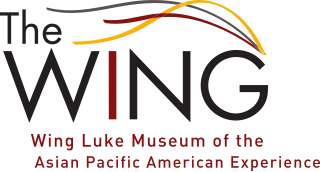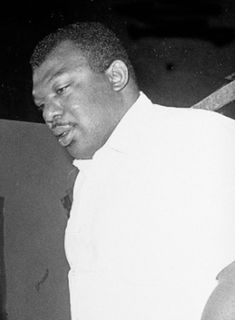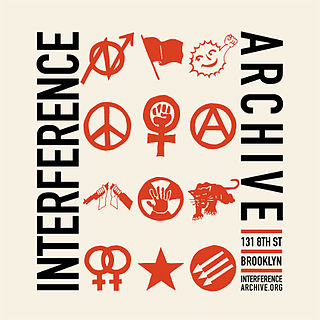
A museum is an institution that cares for a collection of artifacts and other objects of artistic, cultural, historical, or scientific importance. Many public museums make these items available for public viewing through exhibits that may be permanent or temporary. The largest museums are located in major cities throughout the world, while thousands of local museums exist in smaller cities, towns, and rural areas. Museums have varying aims, ranging from the conservation and documentation of their collection, serving researchers and specialists to catering to the general public. The goal of serving researchers is not only scientific, but intended to serve the general public.

Hard-edge painting is painting in which abrupt transitions are found between color areas. Color areas are often of one unvarying color. The Hard-edge painting style is related to Geometric abstraction, Op Art, Post-painterly Abstraction, and Color Field painting.

A curator is a manager or overseer. When working with cultural organizations, a curator is typically a "collections curator" or an "exhibitions curator", and has multifaceted tasks dependent on the particular institution and its mission. In recent years the role of curator has evolved alongside the changing role of museums, and the term "curator" may designate the head of any given division. More recently, new kinds of curators have started to emerge: "community curators", "literary curators", "digital curators" and "biocurators".

The Anacostia Community Museum is a community museum in the Anacostia neighborhood of Washington, D.C., in the United States. It is one of twenty museums under the umbrella of the Smithsonian Institution and was the first federally funded community museum in the United States. The museum, founded in 1967, was created with the intention to bring aspects of the Smithsonian museums, located on the National Mall, to the Anacostia neighborhood, with the hope that community members from the neighborhood would visit the main Smithsonian museums. It became federally funded in 1970 and focuses on the community in and around Anacostia in its exhibitions. This museum also houses a library.

Museology or museum studies is the study of museums. It explores the history of museums and their role in society, as well as the activities they engage in, including curating, preservation, public programming, and education.

The Wing Luke Museum of the Asian Pacific American Experience is a history museum in Seattle, Washington, United States, which focuses on the culture, art and history of Asian Pacific Americans. It is located in the city's Chinatown-International District. Established in 1967, the museum is a Smithsonian Institution affiliate and the only pan-Asian Pacific American community-based museum in the country. It has relocated twice since its founding, most recently to the East Kong Yick Building in 2008. In February 2013 it was recognized as one of two dozen affiliated areas of the U.S. National Park Service.

The Museum of Fine Arts in Boston, Massachusetts, is the 14th-largest art museum in the world, measured by public gallery area. It contains more than 450,000 works of art, making it one of the most comprehensive collections in the Americas. It is home to 8,161 paintings, surpassed among American museums only by the Metropolitan Museum of Art in New York City. With more than 1.2 million visitors a year, it is the 52nd most visited art museum in the world as of 2019.

The Autry Museum of the American West is a museum in Los Angeles, California, dedicated to exploring an inclusive history of the American West. Founded in 1988, the museum presents a wide range of exhibitions and public programs, including lectures, film, theater, festivals, family events, and music, and performs scholarship, research, and educational outreach. It has two sites and attracts about 150,000 visitors annually.
Public humanities is the work of engaging diverse publics in reflecting on heritage, traditions, and history, and the relevance of the humanities to the current conditions of civic and cultural life. Public humanities is often practiced within federal, state, nonprofit and community-based cultural organizations that engage people in conversations, facilitate and present lectures, exhibitions, performances and other programs for the general public on topics such as history, philosophy, popular culture and the arts. Public Humanities also exists within universities, as a collaborative enterprise between communities and faculty, staff, and students.
The Pew Center for Arts & Heritage is a nonprofit grantmaking organization and knowledge-sharing hub for arts and culture in Philadelphia, Pennsylvania, established in 2005. In 2008, Paula Marincola was named the first executive director. The Center receives funding from The Pew Charitable Trusts and makes project grants in two areas, Performance and Exhibitions & Public Interpretation, as well as awarding grants to individual artists through Pew Fellowships. In 2021, the Center announced the introduction of Re:imagining Recovery grants to assist in COVID-19 recovery.
Shared historical authority is a current trend in museums and historical institutions which aims to open the interpretation of history to the public.

John Robert Edward Kinard was an American social activist, pastor, and museum director. He is best known as the director of the Anacostia Museum, a small community museum founded by the Smithsonian Institution in 1967. Kinard was the museum's first director, and remained in the post until his death. The Washington Post said Kinard was "a passionate believer in the idea that the well-being of black people depends on having a record of their past". Noted British archeologist and museologist Sir Kenneth Hudson said Kinard "developed the Anacostia Museum into one of the small number of museums of influence in the world."

Portia James was an American curator and historian. A specialist in African-American material culture, she worked as the cultural resources manager of the Anacostia Community Museum.
Michael Atwood Mason is an American folklorist and museum professional. He was, up to February 2021, the Director of the Smithsonian Center for Folklife and Cultural Heritage.
The Jerusalem Center for the Visual Arts (JCVA) is an international artists-in-residence program that hosts artists and curators in Israel.
Cecil Fergerson was an African-American art curator and community activist. He is widely credited with fostering African-American and Latin-American art communities in Los Angeles for more than 50 years, and was named a "Living Cultural Treasure" by the city in 1999. While working at the Los Angeles County Museum of Art (LACMA), Fergerson co-founded the Black Arts Council (BAC) to advocate for African-American artists and support their community. His advocacy at LACMA and BAC led to seminal exhibitions of African-American art in the early 1970s.

Interference Archive is a volunteer-run library, gallery, and archive of historical materials related to social and political activism and movements. It is located in the Park Slope neighborhood of Brooklyn, New York City, at 314 7th St, Brooklyn, NY 11215. The mission of the organization is "to explore the relationship between cultural production and social movements."
Lilian Thomas Burwell is a Washington, DC sculptor and painter whose shaped paintings often blur the line between the two disciplines. Her artwork uses abstraction to create a personal response to the natural world.
Doreen Garner is an American sculptor and performance artist. Her art practice explores where history, power, and violence meet on the body via beauty or medicine. Garner has exhibited at a number of venues, including Abrons Arts Center, Pioneer Works, Socrates Sculpture Park, The National Museum of African American History in Washington, D.C., Museum of Contemporary African Diasporan Art in Brooklyn, and Chrysler Museum of Art in Norfolk, Virginia. Garner holds a monthly podcast called #trashDAY with artist Kenya (Robinson). Garner lives and works in Brooklyn, New York.

Zora Martin-Felton is an American museum director and curator. She established the education department at the Anacostia Community Museum, which is a museum in the Smithsonian Institution, and worked as the Education Director there. From the 1960s until the 1990s she was the Assistant Director of that museum.











